
Credits: Rafael Moco & Josan Gonzalez
If you're familiar with the 1984 novel Neuromancer, you've probably heard about William Gibson before. Pioneer of cyberpunk literature and father of the term “cyberspace”, Gibson is a renowned American-Canadian writer, whose works - including Neuromancer - have significantly influenced the science fiction genre, academia, modern culture, fashion, and technology.
Written on a mechanical typewriter, his most popular novel, Neuromancer, was released in the same month the Macintosh was first introduced to the general public in 1984. Think about it — two decades before myspace, youtube and instagram were invented — Gibson was talking about digitalization of media, digital influencers, internet celebrities, artificial intelligence, and how decentralized media would counter the power of traditional "top-down" mainstream media.
Gibson’s writing career spans several decades, with his works primarily exploring themes of dystopian futures, technology, and cybernetics. While Neuromancer is considered Gibson's most famous and popular book, few people know any of his fantastic books and novels.
In this post we're going to explore some of William Gibson's most important novels that came before and after Neuromancer, with some of them being an absolute must-read for all science fiction and cyberpunk literature aficionados.
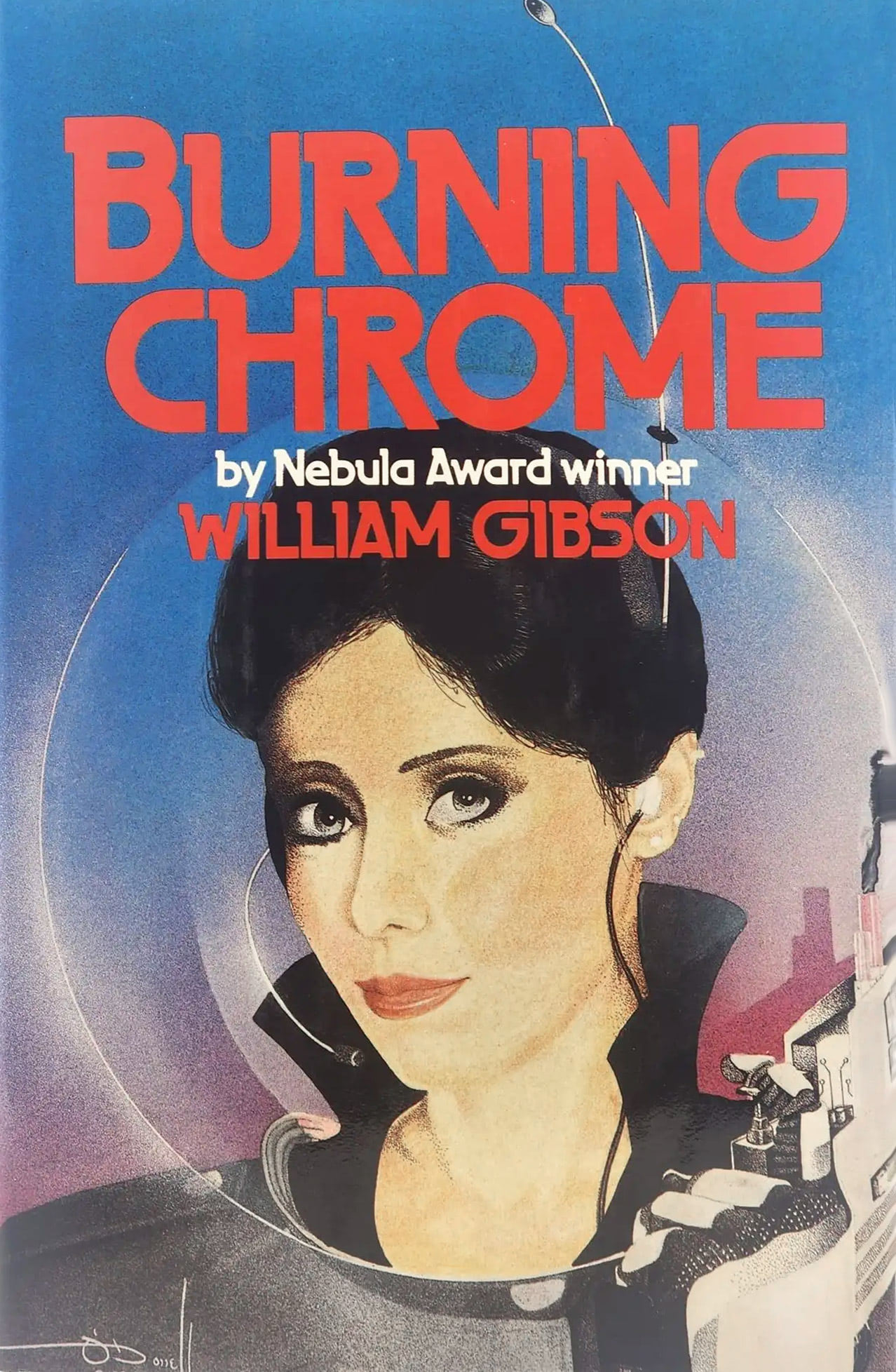
©Credits: Rich O'Donnell/Arbor House Burning Chrome (1981 - 1986)
A Glimpse into the cyberpunk genesis, Burning Chrome is a collection of early short stories by William Gibson, where the (now popular) term "cyberspace" was originally coined by the author himself.
In the realm of science fiction, few works have had as profound an impact on the genre. The collection explores various themes of sci-fi and early cyberpunk concepts, and it introduces the character Molly Millions, who plays a significant role in Gibson’s Sprawl trilogy, which begins with Neuromancer and concludes with Mona Lisa Overdrive.
This seminal short story, first published in Omni magazine in July 1982, not only introduced the term “cyberspace” but also laid the groundwork for the cyberpunk movement that would come to define a generation of speculative fiction.
Burning Chrome tells the tale of two freelance hackers, Automatic Jack and Bobby Quine. Jack, the narrator and a hardware specialist, and Bobby, a software expert, navigate the treacherous waters of the digital underworld. Bobby, driven by his infatuation with a girl named Rikki, convinces Jack to use a powerful Russian “icebreaker” program to hack into the system of a notorious criminal known as Chrome.
Their cyber heist is successful, and they manage to drain Chrome’s bank accounts. However, the victory is bittersweet as they learn that Rikki, the object of Bobby’s affection, had been working in a brothel with ties to Chrome. With her earnings, she purchases cybernetic eye implants and sets off to Hollywood, leaving both men to grapple with their emotions and the consequences of their actions.
Burning Chrome is more than just a story about a heist; it’s a commentary on technology, society, and human relationships. It explores themes of desire, betrayal, and the transformative power of technology. The story was a precursor to Gibson’s Sprawl trilogy of novels and introduced characters and concepts that he would revisit in his later works.
It is a cornerstone of the cyberpunk genre. Its influence can be seen in the works that followed, both in literature and in other media such as film and video games. It remains a powerful narrative that continues to resonate with readers and thinkers, reflecting on the ever-evolving relationship between humanity and technology.
Burning Chrome includes Gibson's inaugural short story, "Johnny Mnemonic", originally published on the same magazine in May 1981. The collection also includes other stories Gibson wrote between 1981 to 1986, which provide a foundation and good understanding of the elements and writing style that paved Gibson's way to Neuromancer and beyond.
For those interested in exploring the roots of cyberpunk and experiencing a story that has shaped modern science fiction, Burning Chrome is an essential read.
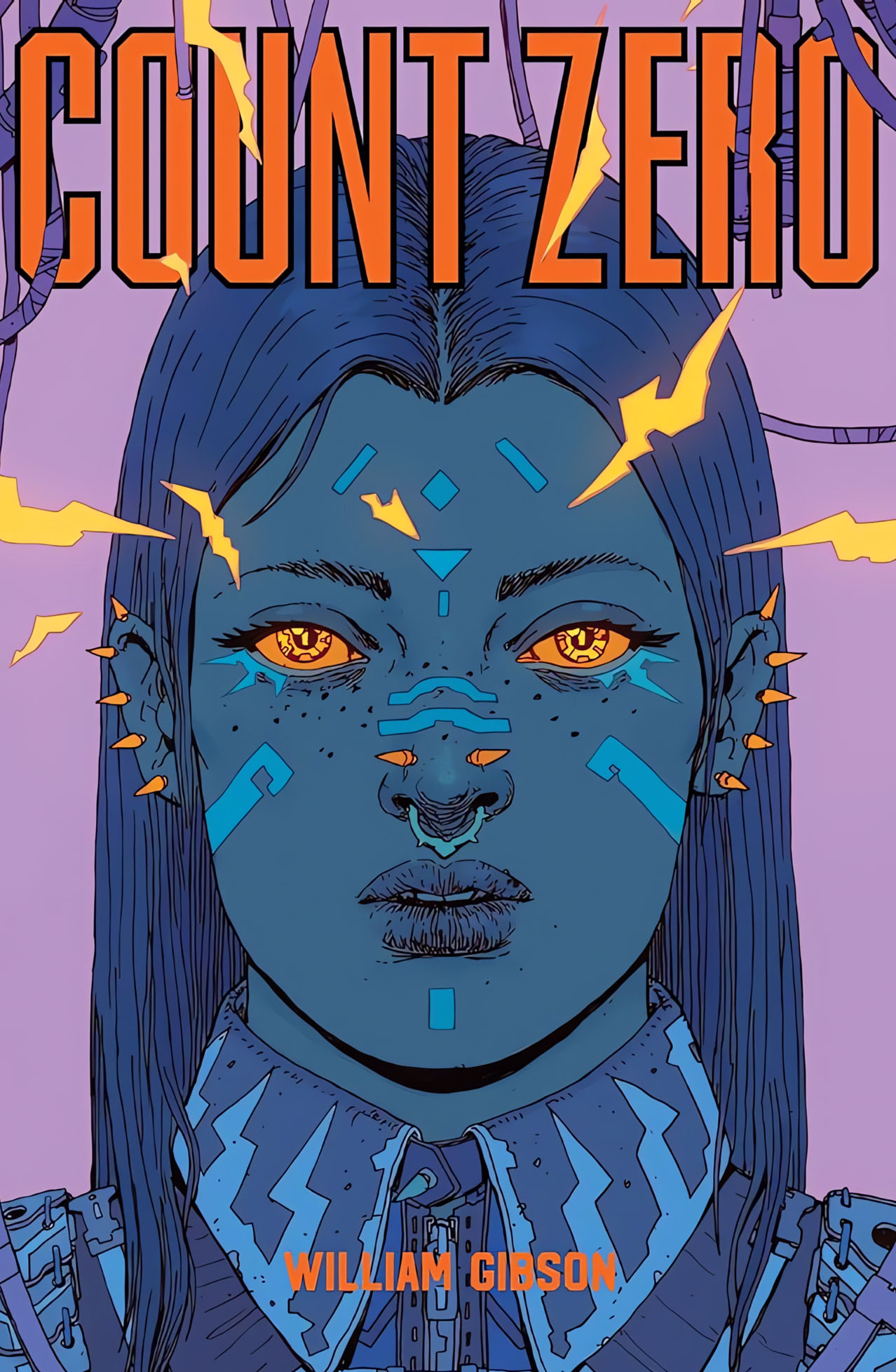
©Credits: Josan Gonzalez/Aleph Count Zero and Mona Lisa Overdrive (1986 - 1988)
“Count Zero” is a science fiction novel that was originally published in 1986. It is the second volume of Gibson’s Sprawl trilogy. The novel is a well-regarded early example of the cyberpunk subgenre.
The story takes place seven years after the events of “Neuromancer”, where strange things begin to happen in the Matrix. This leads to the proliferation of what appear to be voodoo gods, hinted to be the fractured remains of the joined AIs that were Neuromancer and Wintermute. Two powerful multinational corporations are engaged in a battle for control over a powerful new bio-chip technology, using hackers and the Matrix as well as espionage and violence.
The title of the book, other than being the pseudonym of the main character Bobby Newmark, was also claimed by Gibson to be a word-play on the computer programming term count zero interrupt. According to a front leaf of the book, in a “count zero interrupt”, an interrupt of a process decrements a counter to zero.
The plot follows multiple story-line threads that eventually intertwine. One of the threads involves Turner, a corporate mercenary soldier, who has been hired by former partner Conroy to help Christopher Mitchell, a brilliant researcher and bio-hacker, make an illegal career move from Maas’ corporate fortress built into a mesa in the Arizona desert to Hosaka, a rival corporation. The attempt is a disaster, and Turner ends up escaping with Angie Mitchell, the scientist’s young daughter, instead. Implanted in her brain by her father, she carries the secret plans of the construction of the valuable “biosoft” that has made Maas so influential and powerful.
Mona Lisa Overdrive, published in 1988, is the final novel of the Sprawl trilogy. It takes place eight years after the events of Count Zero and continues to explore the cyberpunk world that Gibson has created.
The story concerns Mona, a teen prostitute who resembles famed Simstim superstar Angie Mitchell. Mona is hired by shady individuals for a “gig” which later turns out to be part of a plot to abduct Angie. Another thread focuses on a young Japanese girl named Kumiko, daughter of a Yakuza boss sent to London to keep her safe while her father engages in a gang war. In London, she meets Molly Millions (who now calls herself “Sally Shears”), who takes the girl under her wing.
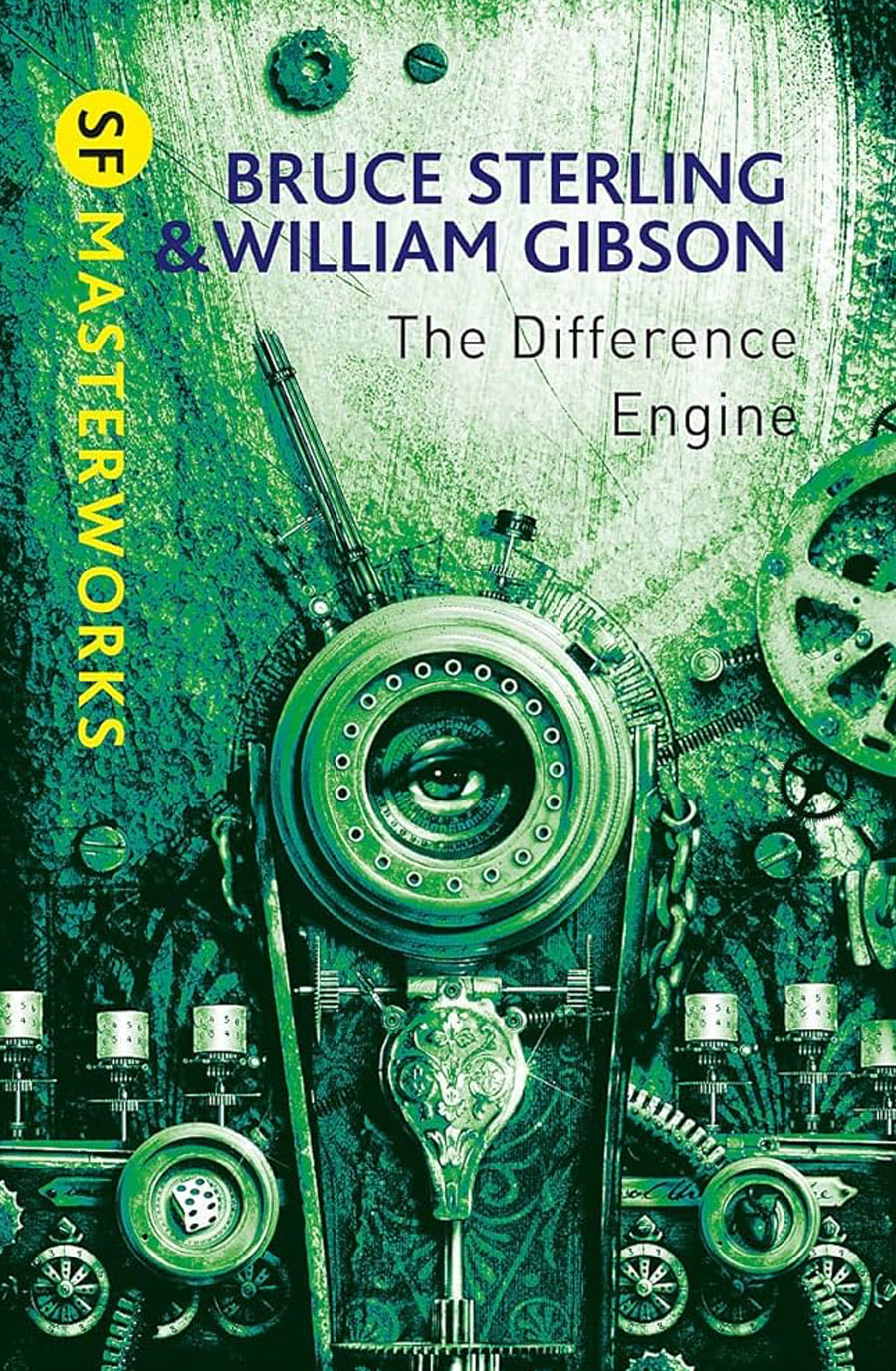
©Credits: S.F. Masterworks The Difference Engine (1990)
One of the first explorations towards the concept of steampunk and its vast universe, “The Difference Engine” is an alternative history novel written by William Gibson and Bruce Sterling.
Originally published in 1990, the novel is widely regarded as a seminal work that helped establish the genre conventions of steampunk.
Set in 1855, the novel presents a Victorian-era Britain where great technological and social change has occurred after the successful invention of a mechanical computer by Charles Babbage.
This divergence from our timeline begins around 1824, when Babbage completes his Difference Engine and proceeds to develop an Analytical Engine.
The novel explores the social consequences of an information technology revolution in the nineteenth century, such as the emergence of “clackers”, technologically-proficient people skilled at programming the Engines through the use of punched cards.
The British Empire is more powerful than in our reality due to the development and use of advanced steam-driven technology in industry.
“The Difference Engine” was nominated for several awards, including the British Science Fiction Award in 1990, the Nebula Award for Best Novel in 1991, and both the John W. Campbell Memorial Award and the Prix Aurora Award in 1992.
It is a provocative, compelling, and intensely imagined novel, a startling extension of Gibson’s and Sterling’s unique visions in a new and totally unexpected direction.
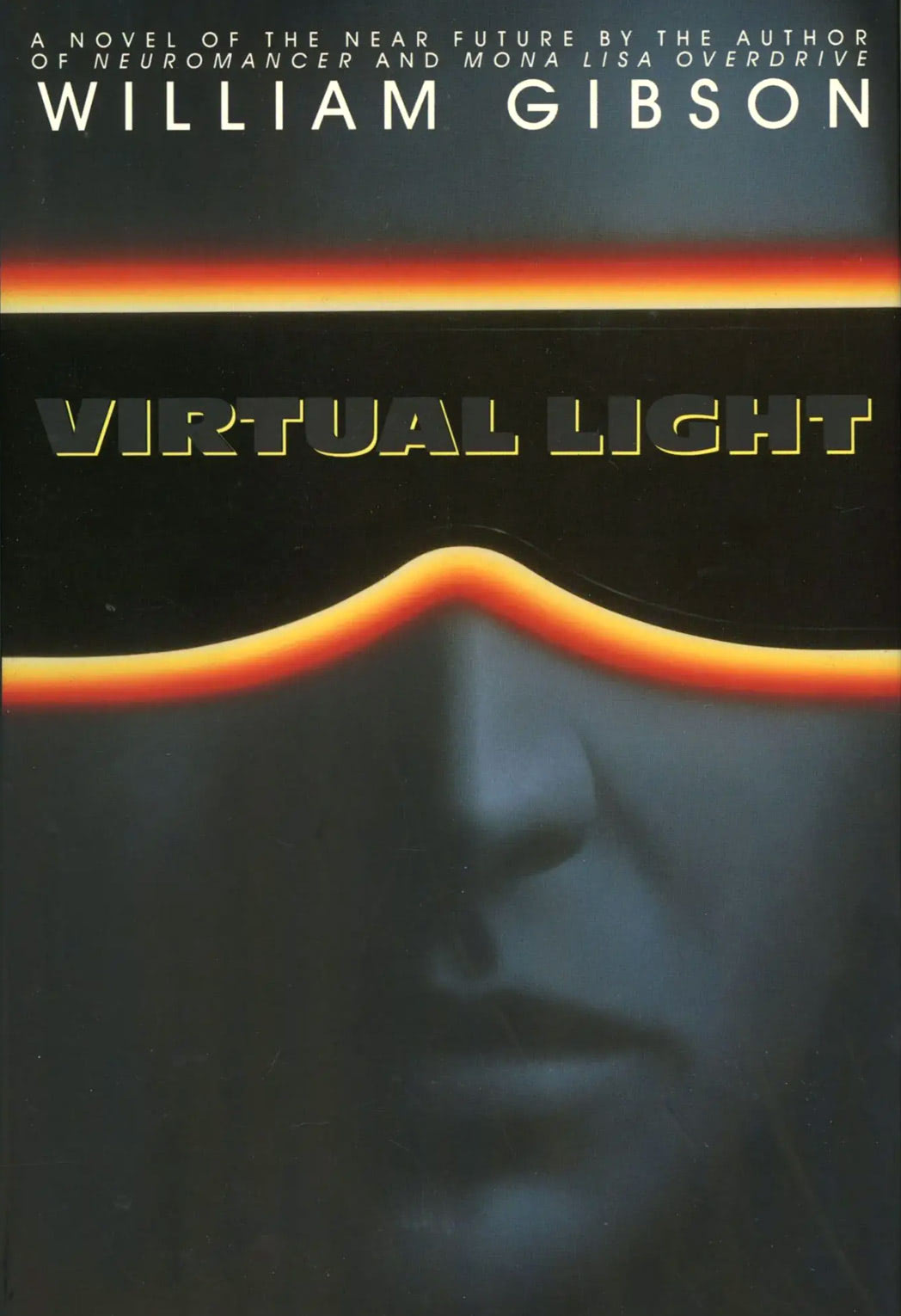
©Credits: Random House Publishing Virtual Light (1993)
The first book in the Bridge trilogy, Virtual Light is set in a postmodern, dystopian, cyberpunk future. The term ‘Virtual Light’ was coined by scientist Stephen Beck to describe a form of instrumentation that produces optical sensations directly in the eye without the use of photons.
The plot centers around Chevette Washington, a young bicycle messenger who lives in the ad hoc, off-the-grid community that has grown on the San Francisco-Oakland Bay Bridge in the aftermath of a devastating earthquake.
Chevette, on a whim, steals a pair of dark-rimmed glasses from a man at a party because she finds him loathsome. Soon after, she realizes that the glasses have unlikely importance, as security company henchmen begin tracking and following her.
The glasses contain plans by a powerful corporation to rebuild San Francisco entirely using nanotechnology, and for that reason, they are highly coveted and present a danger to the person who possesses them.
Meanwhile, Berry Rydell, a former cop turned private security agent, is contracted to recover the glasses for Lucius Warbaby, an intimidating and presumably successful “skip-tracer”, a sort of bondsman/bounty hunter. When Rydell is given the mission, he is not informed of the significance of the glasses and the information they contain.
Eventually, the plot climaxes when Rydell, along with other characters, catch up with Chevette. Rydell escapes the scene with Chevette, and they flee their enemies, who have all the advantages of wealth and technology on their side. A subplot also focuses on a romantic relationship between Chevette and Rydell.

©Credits: Putnam/Penguin Group Idoru (1996)
“Idoru” is the second book in Gibson’s Bridge trilogy. The novel is set in a postmodern, dystopian and cyberpunk future.
The story unfolds in a futuristic Tokyo, rebuilt after an earthquake, and introduces the character Colin Laney, who has a unique talent for identifying nodal points, which are points of particular relevance. This talent is used to sift through vast amounts of mundane data. Laney’s node-spotter function is seen as a metaphor for Gibson’s own method of spotting bits of the literal future in the present.
The plot revolves around rock and roll megastar Rez, of the musical group Lo/Rez, who has declared his intention to marry a synthetic personality named Rei Toei, the Idoru (a Japanese virtual idol) of the title.
This claim is so unusual that it is questioned by his loyal staff, particularly by his head of security, Keith Blackwell. Blackwell believes that someone is manipulating Rez and hires Laney to find out who.
Simultaneously, the Seattle chapter of the Lo/Rez fan club is discussing the same topic of the unbelievable marriage of human and AI construct. Fourteen-year-old Chia Pet McKenzie is chosen by the group to go to Tokyo and meet with the Tokyo chapter to find out what is really happening.
Idoru is a satire on technology dependency and longing, with Tokyo portrayed as a factory where artifacts and popular culture figures are rebranded. The city is recontextualized against a perpetual dismantling and renewal of real and metastructures.
The novel explores themes of media, identity, and reality in a high-tech, postmodern world. It is a witty futuristic thriller that delves into the implications of technology on society and culture.
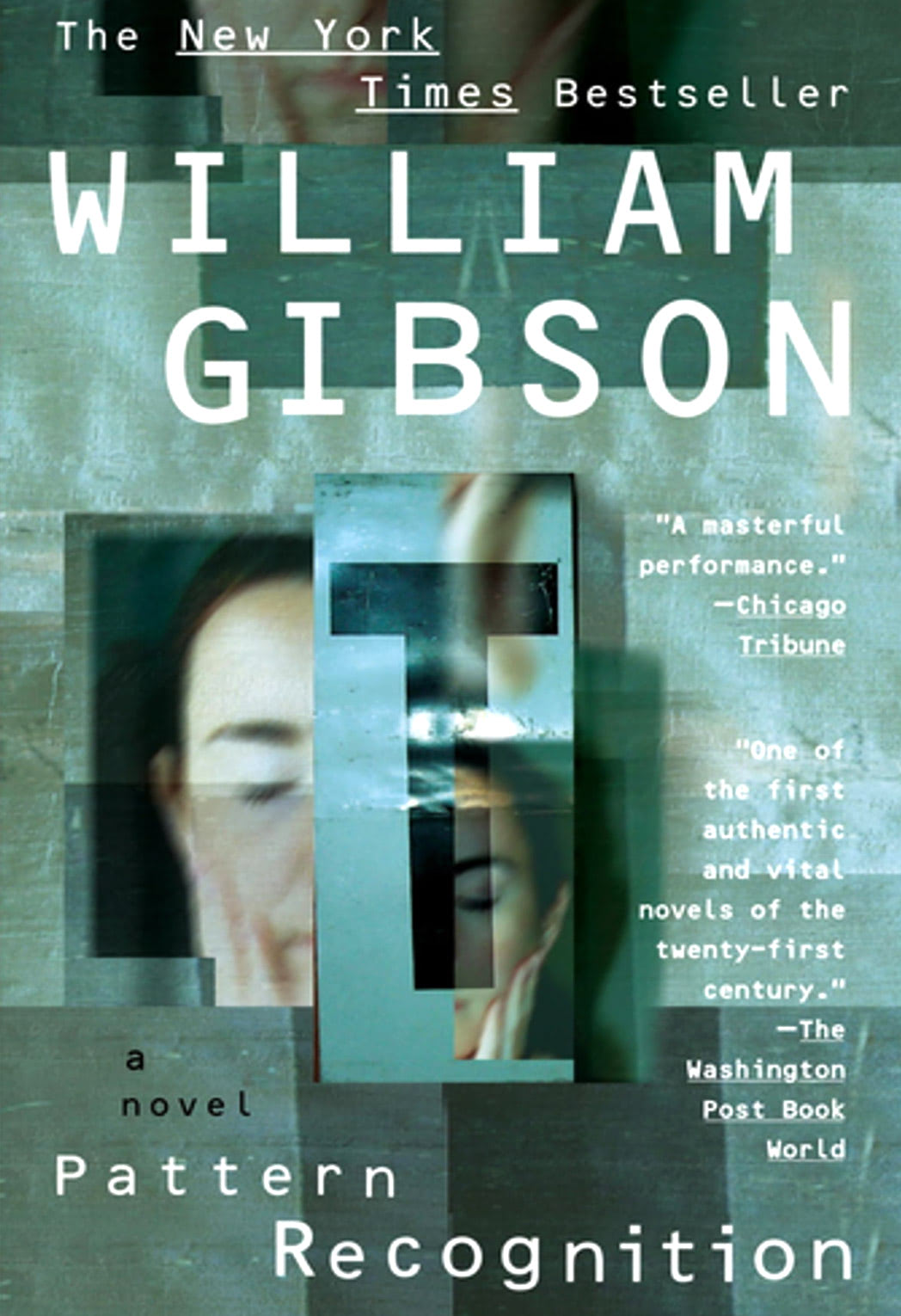
©Credits: Berkley Books Pattern Recognition (2003)
“Pattern Recognition” is Gibson’s eighth novel and his first one to be set in the contemporary world. The story is set in August and September 2002 and follows Cayce Pollard, a 32-year-old marketing consultant who has a psychological sensitivity to corporate symbols.
The action takes place in London, Tokyo, and Moscow as Cayce judges the effectiveness of a proposed corporate symbol and is hired to seek the creators of film clips anonymously posted to the internet.
The novel’s central theme involves the examination of the human desire to detect patterns or meaning and the risks of finding patterns in meaningless data. Other themes include methods of interpretation of history, cultural familiarity with brand names, and tensions between art and commercialization.
Cayce is a legend in the field of market research, paid handsomely to recognize cultural and social patterns that corporations can turn into cash. Her sensitivity is closer to allergy, a morbid and sometimes violent reactivity to the symbols of the marketplace.
A more intriguing project emerges when the head of the firm asks her to determine who’s producing a mysterious series of video fragments that have gripped the imaginations of people around the world.
Like his previous work, it has been classified as a science fiction and postmodern novel, with the action unfolding along a thriller plot line. Critics approved of the writing but found the plot unoriginal and some of the language distracting.
The book peaked at number four on the New York Times Best Seller list, was nominated for the 2003 British Science Fiction Association Award, and was shortlisted for the 2004 Arthur C. Clarke Award and Locus Awards.
Final Notes
William Gibson’s bibliography is a testament to his innovative storytelling and his ability to envision complex, technologically advanced futures. His works have not only shaped the cyberpunk culture but also continue to influence contemporary fashion, arts and society in general. Gibson’s unique blend of technology, culture, and social commentary ensures his place as one of the most influential science fiction writers of our time.
Marking its 40th anniversary, Neuromancer is currently being adapted to a 10-episode TV series streaming soon on Apple TV+, consolidating the novel's status as ground zero for everything cyberpunk.
New to Gibson's work? Get your copy of the 1984 cyberpunk novel Neuromancer from Hypebrother.
Back to The Blog®
If you're familiar with the 1984 novel Neuromancer, you've probably heard about William Gibson before. Pioneer of cyberpunk literature and father of the term “cyberspace”, Gibson is a renowned American-Canadian writer, whose works - including Neuromancer - have significantly influenced the science fiction genre, academia, modern culture, fashion, and technology.
Written on a mechanical typewriter, his most popular novel, Neuromancer, was released in the same month the Macintosh was first introduced to the general public in 1984. Think about it — two decades before myspace, youtube and instagram were invented — Gibson was talking about digitalization of media, digital influencers, internet celebrities, artificial intelligence, and how decentralized media would counter the power of traditional "top-down" mainstream media.
Gibson’s writing career spans several decades, with his works primarily exploring themes of dystopian futures, technology, and cybernetics. While Neuromancer is considered Gibson's most famous and popular book, few people know any of his fantastic books and novels.
In this post we're going to explore some of William Gibson's most important novels that came before and after Neuromancer, with some of them being an absolute must-read for all science fiction and cyberpunk literature aficionados.

©Credits: Rich O'Donnell/Arbor House Burning Chrome (1981 - 1986)
A Glimpse into the cyberpunk genesis, Burning Chrome is a collection of early short stories by William Gibson, where the (now popular) term "cyberspace" was originally coined by the author himself.
In the realm of science fiction, few works have had as profound an impact on the genre. The collection explores various themes of sci-fi and early cyberpunk concepts, and it introduces the character Molly Millions, who plays a significant role in Gibson’s Sprawl trilogy, which begins with Neuromancer and concludes with Mona Lisa Overdrive.
This seminal short story, first published in Omni magazine in July 1982, not only introduced the term “cyberspace” but also laid the groundwork for the cyberpunk movement that would come to define a generation of speculative fiction.
Burning Chrome tells the tale of two freelance hackers, Automatic Jack and Bobby Quine. Jack, the narrator and a hardware specialist, and Bobby, a software expert, navigate the treacherous waters of the digital underworld. Bobby, driven by his infatuation with a girl named Rikki, convinces Jack to use a powerful Russian “icebreaker” program to hack into the system of a notorious criminal known as Chrome.
Their cyber heist is successful, and they manage to drain Chrome’s bank accounts. However, the victory is bittersweet as they learn that Rikki, the object of Bobby’s affection, had been working in a brothel with ties to Chrome. With her earnings, she purchases cybernetic eye implants and sets off to Hollywood, leaving both men to grapple with their emotions and the consequences of their actions.
Burning Chrome is more than just a story about a heist; it’s a commentary on technology, society, and human relationships. It explores themes of desire, betrayal, and the transformative power of technology. The story was a precursor to Gibson’s Sprawl trilogy of novels and introduced characters and concepts that he would revisit in his later works.
It is a cornerstone of the cyberpunk genre. Its influence can be seen in the works that followed, both in literature and in other media such as film and video games. It remains a powerful narrative that continues to resonate with readers and thinkers, reflecting on the ever-evolving relationship between humanity and technology.
Burning Chrome includes Gibson's inaugural short story, "Johnny Mnemonic", originally published on the same magazine in May 1981. The collection also includes other stories Gibson wrote between 1981 to 1986, which provide a foundation and good understanding of the elements and writing style that paved Gibson's way to Neuromancer and beyond.
For those interested in exploring the roots of cyberpunk and experiencing a story that has shaped modern science fiction, Burning Chrome is an essential read.

©Credits: Josan Gonzalez/Aleph Count Zero and Mona Lisa Overdrive (1986 - 1988)
“Count Zero” is a science fiction novel that was originally published in 1986. It is the second volume of Gibson’s Sprawl trilogy. The novel is a well-regarded early example of the cyberpunk subgenre.
The story takes place seven years after the events of “Neuromancer”, where strange things begin to happen in the Matrix. This leads to the proliferation of what appear to be voodoo gods, hinted to be the fractured remains of the joined AIs that were Neuromancer and Wintermute. Two powerful multinational corporations are engaged in a battle for control over a powerful new bio-chip technology, using hackers and the Matrix as well as espionage and violence.
The title of the book, other than being the pseudonym of the main character Bobby Newmark, was also claimed by Gibson to be a word-play on the computer programming term count zero interrupt. According to a front leaf of the book, in a “count zero interrupt”, an interrupt of a process decrements a counter to zero.
The plot follows multiple story-line threads that eventually intertwine. One of the threads involves Turner, a corporate mercenary soldier, who has been hired by former partner Conroy to help Christopher Mitchell, a brilliant researcher and bio-hacker, make an illegal career move from Maas’ corporate fortress built into a mesa in the Arizona desert to Hosaka, a rival corporation. The attempt is a disaster, and Turner ends up escaping with Angie Mitchell, the scientist’s young daughter, instead. Implanted in her brain by her father, she carries the secret plans of the construction of the valuable “biosoft” that has made Maas so influential and powerful.
Mona Lisa Overdrive, published in 1988, is the final novel of the Sprawl trilogy. It takes place eight years after the events of Count Zero and continues to explore the cyberpunk world that Gibson has created.
The story concerns Mona, a teen prostitute who resembles famed Simstim superstar Angie Mitchell. Mona is hired by shady individuals for a “gig” which later turns out to be part of a plot to abduct Angie. Another thread focuses on a young Japanese girl named Kumiko, daughter of a Yakuza boss sent to London to keep her safe while her father engages in a gang war. In London, she meets Molly Millions (who now calls herself “Sally Shears”), who takes the girl under her wing.

©Credits: S.F. Masterworks The Difference Engine (1990)
One of the first explorations towards the concept of steampunk and its vast universe, “The Difference Engine” is an alternative history novel written by William Gibson and Bruce Sterling.
Originally published in 1990, the novel is widely regarded as a seminal work that helped establish the genre conventions of steampunk.
Set in 1855, the novel presents a Victorian-era Britain where great technological and social change has occurred after the successful invention of a mechanical computer by Charles Babbage.
This divergence from our timeline begins around 1824, when Babbage completes his Difference Engine and proceeds to develop an Analytical Engine.
The novel explores the social consequences of an information technology revolution in the nineteenth century, such as the emergence of “clackers”, technologically-proficient people skilled at programming the Engines through the use of punched cards.
The British Empire is more powerful than in our reality due to the development and use of advanced steam-driven technology in industry.
“The Difference Engine” was nominated for several awards, including the British Science Fiction Award in 1990, the Nebula Award for Best Novel in 1991, and both the John W. Campbell Memorial Award and the Prix Aurora Award in 1992.
It is a provocative, compelling, and intensely imagined novel, a startling extension of Gibson’s and Sterling’s unique visions in a new and totally unexpected direction.

©Credits: Random House Publishing Virtual Light (1993)
The first book in the Bridge trilogy, Virtual Light is set in a postmodern, dystopian, cyberpunk future. The term ‘Virtual Light’ was coined by scientist Stephen Beck to describe a form of instrumentation that produces optical sensations directly in the eye without the use of photons.
The plot centers around Chevette Washington, a young bicycle messenger who lives in the ad hoc, off-the-grid community that has grown on the San Francisco-Oakland Bay Bridge in the aftermath of a devastating earthquake.
Chevette, on a whim, steals a pair of dark-rimmed glasses from a man at a party because she finds him loathsome. Soon after, she realizes that the glasses have unlikely importance, as security company henchmen begin tracking and following her.
The glasses contain plans by a powerful corporation to rebuild San Francisco entirely using nanotechnology, and for that reason, they are highly coveted and present a danger to the person who possesses them.
Meanwhile, Berry Rydell, a former cop turned private security agent, is contracted to recover the glasses for Lucius Warbaby, an intimidating and presumably successful “skip-tracer”, a sort of bondsman/bounty hunter. When Rydell is given the mission, he is not informed of the significance of the glasses and the information they contain.
Eventually, the plot climaxes when Rydell, along with other characters, catch up with Chevette. Rydell escapes the scene with Chevette, and they flee their enemies, who have all the advantages of wealth and technology on their side. A subplot also focuses on a romantic relationship between Chevette and Rydell.

©Credits: Putnam/Penguin Group Idoru (1996)
“Idoru” is the second book in Gibson’s Bridge trilogy. The novel is set in a postmodern, dystopian and cyberpunk future.
The story unfolds in a futuristic Tokyo, rebuilt after an earthquake, and introduces the character Colin Laney, who has a unique talent for identifying nodal points, which are points of particular relevance. This talent is used to sift through vast amounts of mundane data. Laney’s node-spotter function is seen as a metaphor for Gibson’s own method of spotting bits of the literal future in the present.
The plot revolves around rock and roll megastar Rez, of the musical group Lo/Rez, who has declared his intention to marry a synthetic personality named Rei Toei, the Idoru (a Japanese virtual idol) of the title.
This claim is so unusual that it is questioned by his loyal staff, particularly by his head of security, Keith Blackwell. Blackwell believes that someone is manipulating Rez and hires Laney to find out who.
Simultaneously, the Seattle chapter of the Lo/Rez fan club is discussing the same topic of the unbelievable marriage of human and AI construct. Fourteen-year-old Chia Pet McKenzie is chosen by the group to go to Tokyo and meet with the Tokyo chapter to find out what is really happening.
Idoru is a satire on technology dependency and longing, with Tokyo portrayed as a factory where artifacts and popular culture figures are rebranded. The city is recontextualized against a perpetual dismantling and renewal of real and metastructures.
The novel explores themes of media, identity, and reality in a high-tech, postmodern world. It is a witty futuristic thriller that delves into the implications of technology on society and culture.

©Credits: Berkley Books Pattern Recognition (2003)
“Pattern Recognition” is Gibson’s eighth novel and his first one to be set in the contemporary world. The story is set in August and September 2002 and follows Cayce Pollard, a 32-year-old marketing consultant who has a psychological sensitivity to corporate symbols.
The action takes place in London, Tokyo, and Moscow as Cayce judges the effectiveness of a proposed corporate symbol and is hired to seek the creators of film clips anonymously posted to the internet.
The novel’s central theme involves the examination of the human desire to detect patterns or meaning and the risks of finding patterns in meaningless data. Other themes include methods of interpretation of history, cultural familiarity with brand names, and tensions between art and commercialization.
Cayce is a legend in the field of market research, paid handsomely to recognize cultural and social patterns that corporations can turn into cash. Her sensitivity is closer to allergy, a morbid and sometimes violent reactivity to the symbols of the marketplace.
A more intriguing project emerges when the head of the firm asks her to determine who’s producing a mysterious series of video fragments that have gripped the imaginations of people around the world.
Like his previous work, it has been classified as a science fiction and postmodern novel, with the action unfolding along a thriller plot line. Critics approved of the writing but found the plot unoriginal and some of the language distracting.
The book peaked at number four on the New York Times Best Seller list, was nominated for the 2003 British Science Fiction Association Award, and was shortlisted for the 2004 Arthur C. Clarke Award and Locus Awards.
Final Notes
William Gibson’s bibliography is a testament to his innovative storytelling and his ability to envision complex, technologically advanced futures. His works have not only shaped the cyberpunk culture but also continue to influence contemporary fashion, arts and society in general. Gibson’s unique blend of technology, culture, and social commentary ensures his place as one of the most influential science fiction writers of our time.
Marking its 40th anniversary, Neuromancer is currently being adapted to a 10-episode TV series streaming soon on Apple TV+, consolidating the novel's status as ground zero for everything cyberpunk.
New to Gibson's work? Get your copy of the 1984 cyberpunk novel Neuromancer from Hypebrother.
You May Also Like
 |
 |
 |
If you're a brand, label or designer looking to promote your business, get in touch with us to launch or sell your original products and discuss product placement or campaigns.
